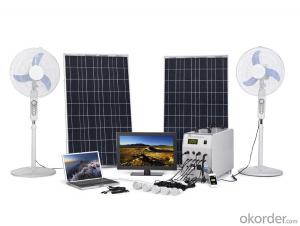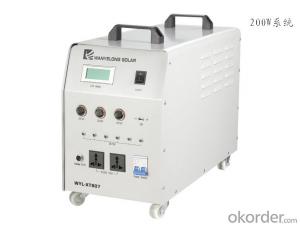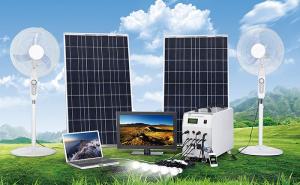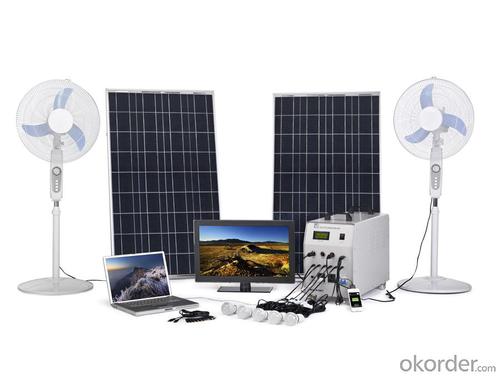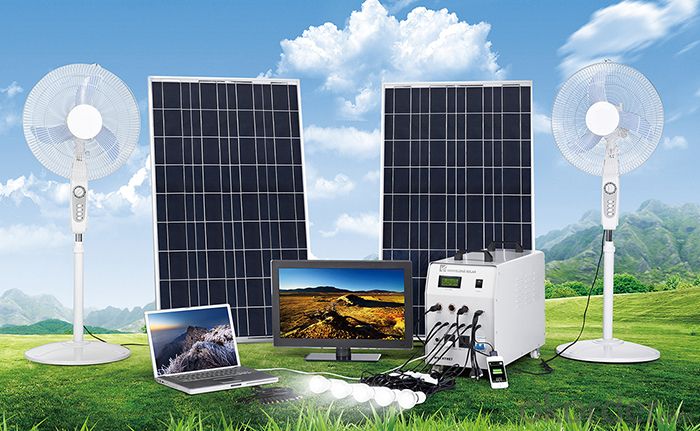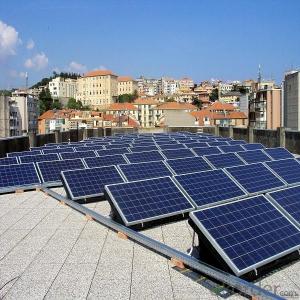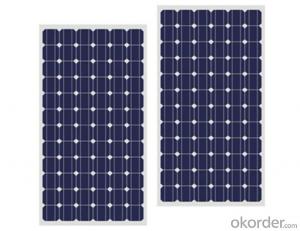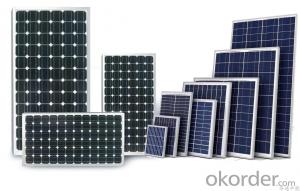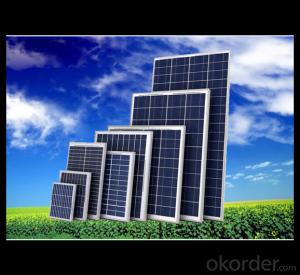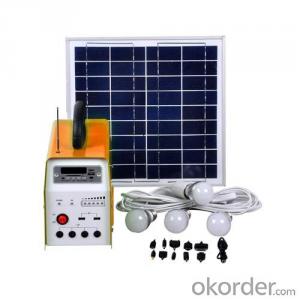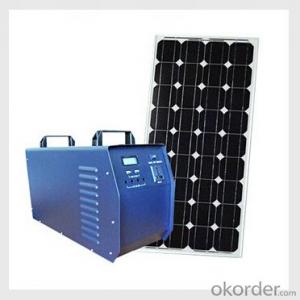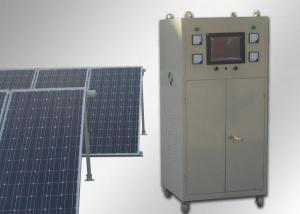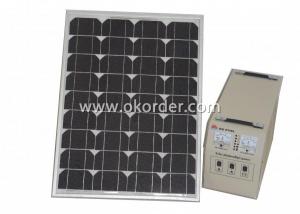Domestic Solar Energy Systems - AC >200W Solar Power System
- Loading Port:
- Guangzhou
- Payment Terms:
- TT OR LC
- Min Order Qty:
- 20 set
- Supply Capability:
- 10000 set/month
OKorder Service Pledge
OKorder Financial Service
You Might Also Like
Light up 4-6 rooms at the same time,with mobile phone charge function,power DC fan,DC TV,Laptop,AC TV,Computer
●Installation,all-in-one DIY Kit;
●5m light cable-with on/off switch;
●Mobile phone charge-for different phones;
●Power Supply-solar or AC adapter;
●Protection-overcharge and over-discharge;
●Pure sine wave inverter built in.
Part | Specification | Qty | |
Solar panel | Poly crystallione type with 10m cable | 100W | ×1 |
Power box | Lead acid rechargeable battery | 55AH/12V | ×1 |
PWM charge controller | 10A/12V | ×1 | |
Pure sine wave inverter | 300W | ×1 | |
AC Output | 220V/110V 50/60Hz | ×1 | |
Cigarette lighter socket output | DC12V | ×2 | |
DC output port | 12V | ×4 | |
USB charge output | 5V | ×1 | |
Others | DC12V LED bulb | 3W | ×4 |
Light holder with 5m cable | On off switch | ×4 | |
USB charge cable | 10 in 1 | ×1 | |
Solar panel mounting bracket | Angle adjustable | ||
DC floor fan (not included) | 15W/12V | ×2 | |
DC TV (not included) | 15inch 30W12V | ×1 | |
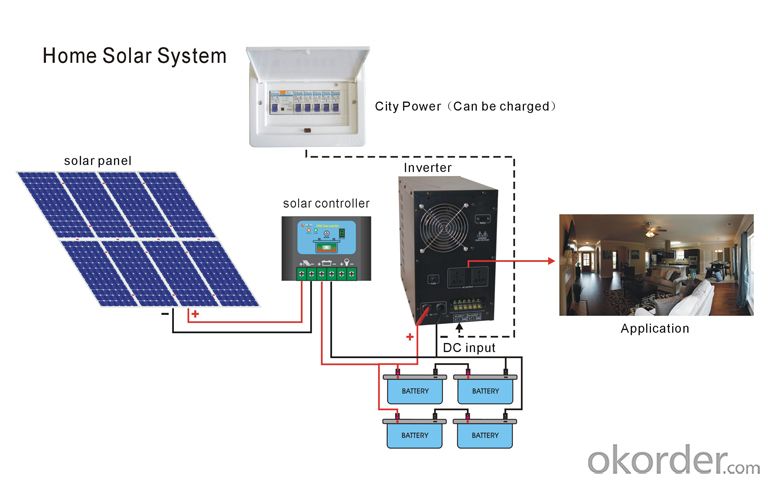
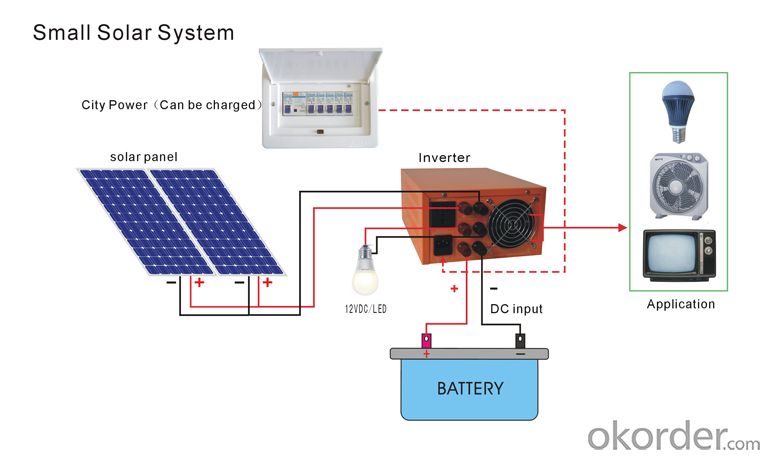
Quantuty
Quality goal:Constant innovation to meet the request of the customers. Protect the environment, provide environmental products to customer.
Quality strategy:
Quality: established high efficiency quality manager system in line with ISO9001 and ISO/TS16949.
Improvement: keeping improvement & quality guarantee.
Efficiency: delivery on time, complete the agreed events with the customers on time.
Service: focus on customers, provide the service and technology support on time.
FAQ
1. How long will my inquiry get response?
Your inquiry related to our products or prices will be replied within 24 hours.
2. Can I get professional service and suggestion?
Well-trained and experienced staffs to answer all your questions in fluent English.
3. Do you accept OEM or customized design?
OEM & ODM, any your customized lightings we can help you to design and put into product.
4. What if I need specific design?
Distributorship are offered for your unique design and some our current models.
- Q: Can solar energy systems be used in conjunction with other energy sources?
- Yes, solar energy systems can be used in conjunction with other energy sources. This is known as a hybrid energy system, where solar power can be combined with other sources such as wind, hydro, or conventional energy grids. By integrating multiple energy sources, it can enhance the reliability and efficiency of the overall energy system, ensuring a consistent power supply even in varying weather conditions or high energy demand.
- Q: Can solar energy systems be used in areas with limited access to sunlight due to shading from nearby buildings or structures?
- Solar energy systems can still be used in areas with limited access to sunlight due to shading from nearby buildings or structures, although their efficiency may be affected. It is important to assess the extent of shading and determine the impact it will have on the solar panels' ability to generate electricity. In situations where shading is minimal and temporary, such as when buildings or structures cast shadows during certain times of the day, solar energy systems can still be viable. However, if the shading is constant and covers a significant portion of the panels throughout the day, it may significantly reduce the system's overall energy production. To mitigate the impact of shading, there are a few options available. One option is to optimize the solar panel placement to maximize exposure to sunlight. This can be achieved by adjusting the tilt angle and orientation of the panels or using tracking systems that follow the sun's path throughout the day. Another option is to use micro-inverters or power optimizers, which are devices that can maximize the output of each individual solar panel, even if some are partially shaded. In more extreme cases of shading, it may be necessary to consider alternative energy solutions or modifications to the nearby structures to minimize shading. This could involve trimming or removing trees, installing reflective surfaces on nearby buildings to redirect sunlight, or using solar panels on other structures with better access to sunlight. Overall, while shading from nearby buildings or structures can reduce the efficiency of solar energy systems, there are still options available to make them viable in areas with limited access to sunlight. It is essential to assess the specific shading conditions and determine the most appropriate solution to maximize energy production.
- Q: Can solar energy systems be used in powering warehouses or distribution centers?
- Yes, solar energy systems can definitely be used in powering warehouses or distribution centers. In fact, many businesses are increasingly adopting solar energy as a sustainable and cost-effective solution for their energy needs. Warehouses and distribution centers are typically large facilities with ample roof space, making them ideal candidates for solar panel installations. By installing solar panels on the roof or ground of these facilities, the generated solar energy can be used to power various operations within the warehouse or distribution center. This includes lighting systems, climate control, refrigeration units, conveyor belts, and other machinery or equipment. The generated energy can also be stored in batteries for later use during cloudy days or at night. Several advantages make solar energy systems a great fit for warehouses and distribution centers. Firstly, solar power helps reduce reliance on the traditional grid, leading to reduced electricity bills and long-term cost savings. Moreover, as solar energy is a renewable and clean energy source, using it reduces greenhouse gas emissions and contributes to a more sustainable business operation. In addition to the cost and environmental benefits, solar energy systems can also provide businesses with energy independence and resilience. By generating their own power, warehouses and distribution centers are less vulnerable to power outages or fluctuations in the grid, ensuring uninterrupted operations and minimizing downtime. Overall, the use of solar energy systems in powering warehouses and distribution centers presents numerous advantages, including cost savings, sustainability, energy independence, and operational resilience. As a result, more and more businesses are embracing solar energy as a reliable and efficient solution for their energy needs in these types of facilities.
- Q: Can solar energy systems be used for powering off-grid agricultural processing facilities?
- Yes, solar energy systems can be used to power off-grid agricultural processing facilities. These systems can generate electricity through photovoltaic panels, which can be utilized to power various equipment and machinery required for processing agricultural products. Solar energy is a sustainable and renewable source, making it an ideal solution for off-grid facilities in remote agricultural areas. Additionally, solar energy systems can be combined with energy storage solutions to ensure a continuous and reliable power supply even during periods of low sunlight. Overall, solar energy systems offer a viable and environmentally-friendly option for powering off-grid agricultural processing facilities.
- Q: Can solar energy systems be used for powering electric vehicle charging pads?
- Yes, solar energy systems can be used to power electric vehicle charging pads. Solar panels can be installed near the charging pads to capture sunlight and convert it into electricity, which can then be used to charge electric vehicles. This allows for sustainable and renewable energy sources to be utilized for electric vehicle charging.
- Q: Can solar energy systems be used in areas with high levels of natural disasters?
- Solar energy systems are indeed suitable for use in areas that frequently experience natural disasters. In fact, these systems can prove to be particularly advantageous in such regions. Unlike traditional power grids, which are susceptible to damage caused by natural disasters, solar energy systems are decentralized and can be easily installed on rooftops or in small arrays. This feature makes them more resilient to disruptions caused by events like hurricanes, earthquakes, or floods. In regions prone to hurricanes or severe storms, solar panels can be installed using mounts and brackets that are specifically designed to withstand high winds. Additionally, solar panels are built to be durable and can withstand hail, thereby minimizing damage during extreme weather conditions. In areas susceptible to earthquakes, solar energy systems can be installed with reinforced mounting systems and structural enhancements to ensure stability during seismic activity. Moreover, solar panels are typically lightweight and flexible, which reduces the risk of structural damage compared to other types of infrastructure. In regions that are prone to flooding, solar panels can be elevated or installed on floating platforms to prevent damage and maintain functionality during periods of high water levels. Furthermore, solar energy systems can provide a reliable source of power when conventional power grids are disrupted due to flooding. Furthermore, solar energy systems can aid in the faster recovery of communities after a natural disaster. By generating electricity locally, solar panels can power critical infrastructure such as emergency shelters, hospitals, and communication systems. This ensures the continuity of essential services during and after a disaster. Overall, solar energy systems offer distinct advantages in areas with high levels of natural disasters. Their decentralized nature, durability, and ability to provide reliable power make them a viable and resilient solution for meeting energy needs in such regions.
- Q: Can solar energy systems be used in remote locations?
- Yes, solar energy systems can be used in remote locations. Unlike traditional power sources, solar energy systems do not require a direct connection to the electricity grid. They can operate independently by harnessing the power of sunlight and converting it into usable electricity. This makes solar energy systems a viable and efficient option for powering remote locations where grid access is limited or non-existent.
- Q: Can solar energy systems be used in powering recreational facilities like gyms or spas?
- Yes, solar energy systems can definitely be used to power recreational facilities like gyms or spas. In fact, many gyms and spas are already utilizing solar energy as a sustainable and cost-effective solution for their power needs. Solar panels can be installed on the roof or in the vicinity of the facility to capture sunlight and convert it into electricity. This clean and renewable energy source can then be used to power various equipment such as lighting, air conditioning, heating, and other electrical systems within the gym or spa. By incorporating solar energy systems, recreational facilities can significantly reduce their reliance on traditional energy sources, such as fossil fuels. This not only helps to reduce carbon emissions and combat climate change but also provides long-term financial benefits. Solar power can result in substantial energy savings over time, as gyms and spas can generate their own electricity and potentially even sell excess power back to the grid. Moreover, solar energy systems can be seamlessly integrated into the design of recreational facilities. The sleek and modern look of solar panels can enhance the overall aesthetic appeal of the facility, while also demonstrating its commitment to environmental sustainability. This can attract environmentally conscious customers who value businesses that prioritize renewable energy and contribute to a greener future. In summary, solar energy systems are a viable and increasingly popular option for powering recreational facilities like gyms or spas. By harnessing the power of the sun, these facilities can reduce their carbon footprint, save on energy costs, and attract environmentally conscious customers.
- Q: How does the color of solar panels affect energy production?
- The color of solar panels does not significantly affect energy production. The efficiency and power output of solar panels are determined by their material and design, not their color. However, darker colors may absorb more heat, which can slightly increase the operating temperature of the panels and decrease their efficiency.
- Q: How do solar energy systems affect electricity bills?
- Solar energy systems can significantly reduce electricity bills by generating free and clean energy from the sun. By harnessing sunlight to produce electricity, these systems offset the need to purchase electricity from the grid. Depending on the size and efficiency of the solar installation, electricity bills can be reduced by a significant amount or even eliminated entirely.
Send your message to us
Domestic Solar Energy Systems - AC >200W Solar Power System
- Loading Port:
- Guangzhou
- Payment Terms:
- TT OR LC
- Min Order Qty:
- 20 set
- Supply Capability:
- 10000 set/month
OKorder Service Pledge
OKorder Financial Service
Similar products
Hot products
Hot Searches
Related keywords
